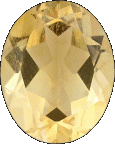| |
Citrine
|
The word citrine comes from the Latin citron which is the name of a fruit related to the lemon. It is a variety of yellow quartz, and owes its color to iron impurities. All citrine is caused by heating amethyst until the ferrous component oxidizes. Though this occurs rarely in nature, the majority of amethyst you encounter will have been heated in a lab. Contrary to popular believe there is not way to discern the natural from the processed by visual inspection because careful heating can produce any shade of citrine from the palest of yellows to the darkest oranges. In fact, the most prized color of citrine, the rich canary yellow, is created through this man made heating process. These stones are still considered natural but should be described as enhanced by ethical dealers. Any merchant that tries to see you a “unheated” citrine is either being dishonest, disingenuous, or downright ignorant.
The folklore attached to this stone is equally difficult to sort out. Because early lapidaries relied on visual inspection to classify gems modern citrines were often called topaz or yellow jasper. The folklore is farther complicated because unscrupulous lapidaries had a history for being passed off as more expensive stones like the yellow diamond or yellow jacinth. That being said there are times where the lapidaries are clearly describing citrine but calling it by another name.
Marbodus is one of the first to examine this dilemma in 18th century lapidary. In that work he categorizes the yellow sapphire as the citrine and the yellow quarts as the “European Topaz”. But he goes on to give all of the clear transparent stones the general properties of protecting travelers, warding off airborne disease, and making authorities look more favorably upon the wearer.
Many folk practices bestow on the stone the power to bring prosperity, and to provide a strange protection from spells and witchcraft. Amulets of this stone do not stop the curse or magical attack but prevent it from doing harm by undoing the charm or uncrossing the individual. A pendant with tigereye and citrine is still worn in Mexico today as a charm against brujas, or evil witches.
|
Colors
|
Translucent pale yellow to deep orange
|
Locations
|
Citrine is found worldwide.
|
Compisition
|
SiO2, Crystaline quartz
|
Hardness
|
6 - 7
|
|

|

|

|
|
|
|
|
|